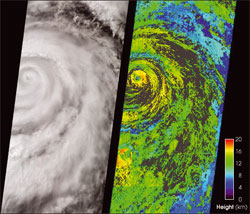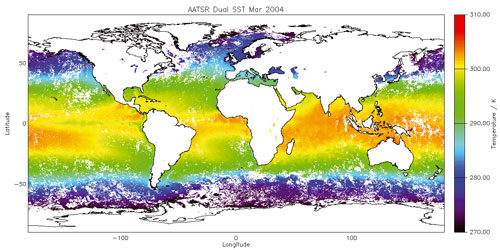Description
Advances in satellite instrumentation have resulted in a general trend towards multi-functional capabilities in many types of sensors - resulting in instruments with the capability to operate using different viewing modes and angles, and multiple polarisations. The latest SAR instruments demonstrate this trend. The category of ‘multiple direction/polarisation instruments’ is used here however to describe instruments which are custom-built for observing, as their primary function, directional or polarisational characteristics of the target’s signature (either visible/IR or microwave), as a means of deriving geophysical information.
Multi-directional radiometers can make observations of the diffused or emitted radiation from a particular element of the Earth’s surface or clouds from more than one incidence angle. In this way, information on anisotropies in the radiation may be identified. The emphasis in these instruments is on spectral rather than spatial information with the result that the detection channels, which typically span the visible to the IR, are precisely calibrated and the spatial resolution is usually of order 1km.
Polarimetric radiometers are used for applications in which radiative information is embedded in the polarisation state of the transmitted, reflected or scattered wave. Some polarimetic radiometers also have a multi-directional capability so that directional information can be determined.
Applications
Using IR channels, multiple-angle viewing capabilities are used to achieve accurate corrections for the effects of (variable) atmospheric absorption and therefore to infer precise temperature values, for example, of sea and land surfaces. Multi-directional radiometers are also capable of measuring cloud cover and cloud top temperature together with atmospheric water vapour and liquid water content.
In the visible and near IR spectrum, these instruments allow for improved measurements of the scattering properties of particles such as aerosols, and for the angular characteristics of the various contributions to the Earth radiation budget, including surface albedo, to be measured. They also enable accurate measurement of parameters such as Normalised Difference Vegetation Indices (NDVI) which are used to assess vegetation state and crop yield at regional and global scales. MISR, currently flying on NASA’s Terra mission is providing new types of information for scientists studying Earth's climate, such as the partitioning of energy and carbon between the land surface and the atmosphere, and the regional and global impacts of different types of atmospheric particles and clouds on climate.
Polarisation information is used to infer a variety of parameters, including the size and scattering properties of liquid water, cloud particles and aerosols, as well as additional information on the optical thickness and phase of clouds. Polarimetric radiometers also provide information on the polarisation state of the radiation backscattered from the Earth’s surface which supplements measurements obtained from other land and sea imaging instruments. Such measurements are of interest in a range of applications from investigations of albedo and reflectance to agriculture and the classification of vegetation. ESA’s SMOS mission planned for launch in 2007 will use an L-band (1.4 GHz) dual polarisation microwave interferometer to measure estimates of soil moisture (a key variable for numerical weather and climate models) and ocean salinity (important for ocean circulation models).
 Hurricane Juliette, captured by MISR on 26th September 2001. On the left is a true-color image, on the right is cloud-top height field derived using automated computer processing of the data from multiple MISR cameras. |
 AATSR and its predecessors ATSR-1 and ATSR-2 have undertaken over 13 years of Sea Surface Temperature measurements with the accuracy required for climate research |
| Current & planned instruments AATSR ATSR-2 HYDROS MIRAS (SMOS) MISR POLDER-P SPECTRA |
MISR: www-misr.jpl.nasa.gov |